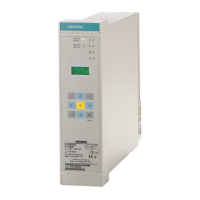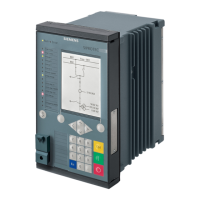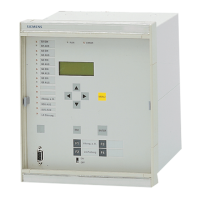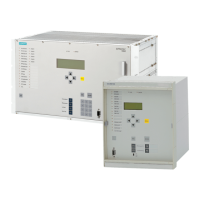Commands that are initiated internally (command processing in the CFC) are not subject to switching
authority and are therefore always "allowed".
Switching Mode
The switching mode determines whether selected interlocking conditions will be activated or deactivated at
the time of the switching operation.
The following switching modes (local) are defined:
•
Local commands (SC = LOCAL)
– interlocked (normal), or
– non-interlocked switching.
The devices in housing of size
1
/
2
(7VE63) are equipped with two key switches. The bottom switch is reserved
for the switching mode. The "Normal" position of the law key switch allows interlocked switching while the
"Interlocking OFF" position allows non-interlocked switching. For devices in housing of size
1
/
3
(7VE61) the
switching mode can be changed between "interlocked (latched)" and "non-interlocked (unlatched)" in the
operator panel after having entered the password or by means of CFC also via binary input and function key.
The following switching modes (remote) are defined:
•
Remote or DIGSI commands (SC = LOCAL, REMOTE, or DIGSI)
– interlocked, or
– non-interlocked switching. Here, deactivation of interlocking is accomplished via a separate
command. The position of the key-switch is irrelevant.
– For commands from CFC (SC = AUTO SICAM), please observe the notes in the CFC manual (compo-
nent: BOOL to command).
Zone Controlled / Field Interlocking
Zone controlled / field interlocking (e.g. via CFC) includes the verification that predetermined switchgear posi-
tion conditions are satisfied to prevent switching errors (e.g. disconnector vs. ground switch, ground switch
only if no voltage applied) as well as verification of the state of other mechanical interlocking in the switch-
gear bay (e.g. High Voltage compartment doors).
Interlocking conditions can be programmed separately, for each switching device, for device control CLOSE
and/or OPEN.
The enable information with the data "switching device is interlocked (OFF/NV/FLT) or enabled (ON)" can be
set up,
•
directly, using a single point or double point indication, key-switch, or internal indication (marking), or
•
by means of a control logic via CFC.
When a switching command is initiated, the actual status is scanned cyclically. The assignment is done via
"Release object CLOSE/OPEN".
System Interlocking
Substation Controller (System interlocking) involves switchgear conditions of other bays evaluated by a central
control system.
Double Activation Blockage
Parallel switching operations are interlocked. As soon as the command has arrived all command objects
subject to the interlocking are checked to know whether a command is being processed. While the command
is being executed, interlocking is enabled for other commands.
Blocking by Protection
The pickup of protective elements blocks switching operations. Protective elements are configured, separately
for each switching component, to block specific switching commands sent in CLOSE and TRIP direction.
Functions
2.15 Command Processing
SIPROTEC 4, 7VE61 and 7VE63, Manual 139
C53000-G1176-C163-3, Edition 10.2017
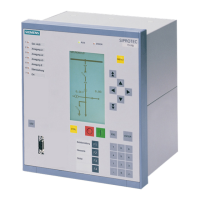
